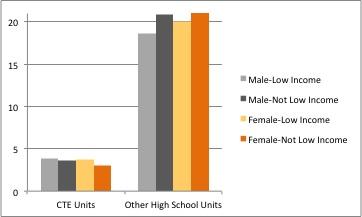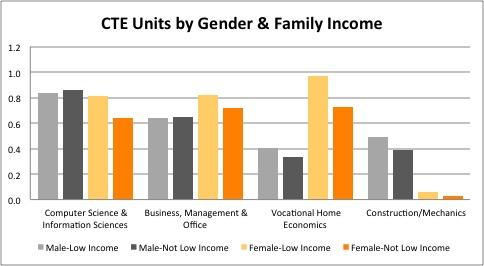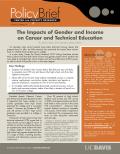The Impacts of Gender and Income on Career and Technical Education
by Mary Cashen, 2012 Visiting Graduate Scholar
For decades, high school students have taken technical training classes that prepare them for jobs, but little research has examined the impact these classes have on whether those students go to college.
In a new study, Center for Poverty Research 2012 Visiting Graduate scholar Mary Cashen finds that both family income and gender predict which students are more likely to complete high school Career and Technical Education (CTE) courses, as well as which will pursue a two- or four-year degree.
Key Findings
- Students from families with incomes below $25,000 per year are likely to complete more CTE units and fewer other high school units than their higher-income peers.
- About 46% of low-income male students completed courses in computer science, agribusiness, construction trades, mechanics and repairs or precision production, compared to 16% of low-income females.
- To complete traditionally female-dominated vocational courses, such as family and consumer science, makes it less likely a student will enroll in a two- or four-year college.
President Barack Obama’s Career and Technical Education Blueprint makes it imperative that “every student in our country graduates from high school prepared for college and a successful career.”1 However, by October of 2011, only 68 percent of 2011 high school graduates were enrolled in a college or university.
Proponents of high school career and technical education (CTE) argue that its value should not be judged in terms of whether or not they increase the chances an academically weak student will attain a college degree. Career training in high school can prepare students for jobs in a range of fields, including business, computer and information sciences and construction.
Over 95 percent of high school students took at least one CTE course in 2000, and approximately one fourth took three or more courses in the same CTE concentration.4 American high schools students continue to complete CTE courses, which makes it imperative to understand the consequences they have on later education attainment and earnings.
The Data on Career and Technical Training
This study focuses on outlooks for career and technical education
(CTE) in U.S. high schools in the 21st century. It analyzes CTE
course-taking patterns for male and female students from
different socioeconomic backgrounds, and strives to make
conclusions about what policies would improve high school
curriculum for those students who are least likely to complete
college.
This study uses data from the Educational Longitudinal Study of 2002 (ELS: 2002), a nationally representative dataset of high school sophomores in 2002, as well as a second and third wave of data collection in 2004 and 2006. Analyses were conducted only for non-private school students for whom complete high school transcript data was available.
CTE courses are identified as male or female if they were found with a t-test to be dominated by one gender or another. Female-dominated courses were in family and consumer science or home economics, while male-dominated courses were in computer science, agribusiness, construction trades, mechanics and repairs or precision production.
Gendered Courses of Study
The results indicate that young women complete significantly more
family and consumer science education, business and office,
allied health and health sciences and vocational home economics
units than their male counterparts. This is consistent with
previous research. Males from low-income families, and those with
parents without college degrees, are less likely to participate
in female-dominated vocational courses. Males from families with
higher income, and whose parents have a higher level of
education, are not as deterred.
CTE and College Enrollment
Gendered vocational education courses have different effects for
males and females. To complete traditionally female-dominated
vocational education courses reduced the likelihood that the
participant would enroll in a two- or four-year college. Students
who completed male-dominated vocational courses were no more or
less likely to attend a two- or four-year college. However, those
who concentrated in a specific vocation, like culinary school or
construction, were less likely to enroll in a four-year college.
In the “College for All” era, where all students are expected to go to college, careful consideration needs to be taken when enrolling students in vocational coursework, particularly among women. Prior research has shown that, in fact, students trained in female-dominated vocational courses are at a large wage disadvantage compared to those who enroll in a male-dominated vocational education.5 This means that not only are women who pursue a female-dominated vocational education less likely to go to college, they are also less likely to earn a living wage.
Meet the Researcher
Mary Ellen Cashen is a Ph.D. candidate in Educational Policy and
Social Context at UC Irvine. She studies high schools, career and
technical education, poverty, inequality and gender differences
in labor-market outcomes for low-income students. Contact her at:
mcashen@uci.edu.
About the Visiting Graduate Scholars Program
Each year, the Center hosts Ph.D. students from across the
country as Visiting Graduate Scholars to conduct poverty research
in a variety of disciplines, including economics, psychology,
sociology, social work, public policy, law and education. Their
coursework and research during their stay expands their
understanding of the causes and consequences of poverty, and
offers faculty mentorship and support in their work.
References
Arum, Richard, and Yossi Shavit. 1995. “Secondary Vocational
Education and the Transition from School to Work.” Sociology of
Education 68:187-204.
Building New Possibilities: Promising Practices for Recruiting and Retaining Students in Career and Technical Education Programs That Are Nontraditional for Their Gender.” The Association for Career and Technical Education, 2009.
“College Enrollment and Work Activity of 2011 High School Graduates,” U.S. Bureau of Labor Statistics, April 2012. ww.fns.usda.gov.
“Investing in America’s Future: A Blueprint for Transforming Career and Technical Education,” U.S. Department of Education, April 2012.
“National Assessment of Vocational Education: Final Report to Congress,” U.S. Department of Education, 2004.














